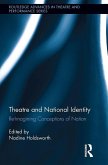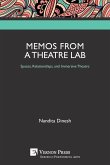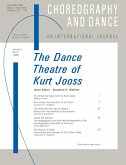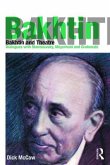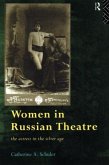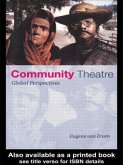Nicola Savarese
Eurasian Theatre
Drama and Performance Between East and West from Classical Antiquity to the Present
Nicola Savarese
Eurasian Theatre
Drama and Performance Between East and West from Classical Antiquity to the Present
- Broschiertes Buch
- Merkliste
- Auf die Merkliste
- Bewerten Bewerten
- Teilen
- Produkt teilen
- Produkterinnerung
- Produkterinnerung
The distances that separate East from West - the two extremes of the Eurasian continent - are enormous. Yet, since ancient times, the people of Europe and Asia have tried to overcome this remoteness through a network of trade routes known as the Silk Road. The great migrations, the continuous military conquests and the paths relentlessly opened up by merchants have been at the origin of ideological, technical and artistic exchanges, resulting in a fusion of cultures. Among the ceaseless travellers on the routes of the Silk Road, along with soldiers, merchants, messengers, and pilgrims, we find…mehr
Andere Kunden interessierten sich auch für
![Theatre and National Identity Theatre and National Identity]() Theatre and National Identity61,99 €
Theatre and National Identity61,99 €![Post-War British Theatre Criticism (Routledge Revivals) Post-War British Theatre Criticism (Routledge Revivals)]() John ElsomPost-War British Theatre Criticism (Routledge Revivals)28,99 €
John ElsomPost-War British Theatre Criticism (Routledge Revivals)28,99 €![Memos from a Theatre Lab Memos from a Theatre Lab]() Nandita DineshMemos from a Theatre Lab57,99 €
Nandita DineshMemos from a Theatre Lab57,99 €![The Dance Theatre of Kurt Jooss The Dance Theatre of Kurt Jooss]() Suzanne WaltherThe Dance Theatre of Kurt Jooss59,99 €
Suzanne WaltherThe Dance Theatre of Kurt Jooss59,99 €![Bakhtin and Theatre Bakhtin and Theatre]() Dick MccawBakhtin and Theatre73,99 €
Dick MccawBakhtin and Theatre73,99 €![Women in Russian Theatre Women in Russian Theatre]() Catherine SchulerWomen in Russian Theatre74,99 €
Catherine SchulerWomen in Russian Theatre74,99 €![Community Theatre Community Theatre]() Eugene Van ErvenCommunity Theatre58,99 €
Eugene Van ErvenCommunity Theatre58,99 €-
-
The distances that separate East from West - the two extremes of the Eurasian continent - are enormous. Yet, since ancient times, the people of Europe and Asia have tried to overcome this remoteness through a network of trade routes known as the Silk Road. The great migrations, the continuous military conquests and the paths relentlessly opened up by merchants have been at the origin of ideological, technical and artistic exchanges, resulting in a fusion of cultures. Among the ceaseless travellers on the routes of the Silk Road, along with soldiers, merchants, messengers, and pilgrims, we find those who earned their living as jugglers, acrobats, musicians, actors and dancers. They were people who brought with them, rooted in their bodies, their own techniques and histories. Through these performers, the 'fabulous and mysterious Orient' has exerted an ongoing influence on the art of the theatre in Europe and America. In the same way, especially in modern times, actors and dancers from India, China, Japan, and other Asian countries have drawn inspiration from Western dramatic genres for a renewal of their ancient traditions. A long history of travelling actors moving between East and West has slowly taken shape, and lies at the foundation of our contemporary, professional performative arts. This updated and revised edition of Drama and Performance Between East and West (first published in 1992), traces this history from classical antiquity to the present. The book constitutes the first complete in-depth historiographic inquiry into the subject.
Hinweis: Dieser Artikel kann nur an eine deutsche Lieferadresse ausgeliefert werden.
Hinweis: Dieser Artikel kann nur an eine deutsche Lieferadresse ausgeliefert werden.
Produktdetails
- Produktdetails
- Verlag: Taylor & Francis
- Seitenzahl: 640
- Erscheinungstermin: 14. Oktober 2024
- Englisch
- Abmessung: 246mm x 174mm
- Gewicht: 1070g
- ISBN-13: 9781032917993
- ISBN-10: 1032917997
- Artikelnr.: 71716163
- Herstellerkennzeichnung
- Libri GmbH
- Europaallee 1
- 36244 Bad Hersfeld
- gpsr@libri.de
- Verlag: Taylor & Francis
- Seitenzahl: 640
- Erscheinungstermin: 14. Oktober 2024
- Englisch
- Abmessung: 246mm x 174mm
- Gewicht: 1070g
- ISBN-13: 9781032917993
- ISBN-10: 1032917997
- Artikelnr.: 71716163
- Herstellerkennzeichnung
- Libri GmbH
- Europaallee 1
- 36244 Bad Hersfeld
- gpsr@libri.de
Nicola Savarese (born in Rome, in 1945) is a member of the scientific staff of ISTA, the International School of Theatre Anthropology founded in 1980 by Eugenio Barba. He was professor of Performing Arts at the Universities of La Sapienza (Rome), Lecce, Bologna, and Roma Tre. He has also lectured at the Universities of Kyoto, Montreal, and Sorbonne III. He has travelled widely in Asia and particularly in Japan, where he lived for two years. His research and publications focus mainly on the complex dynamics of the encounters between Asian and Western theatres. His books include, among others: Il teatro al di la' del mare (The Theatre beyond the sea, 1980), Parigi/Artaud/Bali (1997) and, in collaboration with Eugenio Barba, A Dictionary of Theatre Anthropology. The Secret Art of the Performer (1997) that has been translated into many languages. His research on classical Roman theatre, and in particular on the body-techniques of ancient pantomimes, gave rise to an exhibition inside the Colosseum in Rome (In Scaena Catalogue, 2007). He is also editor of the journals Teatro e Storia and Dyonisus ex machina. (www.nicolasavarese.it)
Preface, by Vicki Ann Cremona; by Nicola Savarese
I. THE 'MASCHERA' OF MARCO POLO. The Exotic Myth of Asia from Antiquity to the Renaissance
1. Asia in Tragedy
2. Alexander's Dream
3. Rome looks to the Orient
4. Mimes and Pantomimes in Rome
5. Byzantine Interludes
6. Jugglers in the Han Court
7. Tang Exoticism
8. The Students from the Pear Garden
9. The Fabulous Asia of the Middle Ages
10. Tartar Clothing for Marco Polo
11. Morris Dances and Moorish Figures
12. Theatre in the Court of the Great Khan
13. Danses Macabres
14. Byzantine Crossroads
15. From Constantinople to Istanbul
16. Costumes from Far
off Countries
17. The Moor of Venice
18. The Prisons of Algiers
II. THE SAVAGE HARLEQUIN
Oriental Exoticism in European Theatre between the Sixteenth and Eighteenth Centuries
1. After the Pepper, the Souls: the Jesuits in Asia
2. False Brahmins
3. Christian Indians and Japanese Martyrs
4. Local Colour
5. Amorous Turks and Gallant Moors
6. The Fake Turk
7. In the Name of the Orient
8. The Turkish March
9. Persian Wives and Indian Widows
10. Arlequin Sauvage
11. The Silent Merchants
12. Idle and Vile Profession
13. The Chinese Fashion
14. Chinese Shadows
15. A Fundamental Misunderstanding
16. The Translations of a Chinese Drama
17. Voltaire's Edifying Orient
18. L'Orphelin de la Chine
III. THE REINCARNATION OF SAKUNTALA
Oriental Theatres Between the Enlightenment and Romanticism
1. The Beginnings of Orientalism
2. Sakuntala in Europe
3. Gautier's Ballet
4. English Entertainments in London
5. William Jones and His Twenty
Eight Tongues
6. Sir William Discovers Sakuntala
7. Theatres in India
8. English Entertainments in Calcutta
9. The Playhouse
10. Mrs. Bristow's Little Theatre
11. Mr. Lebedev's Theatre
12. Philology and Anthropology
13. The Theatres of Bengal
14. A Street Theatre
15. The Dances of the Bayaderes
16. Romanticism and Orientalism
17. In Search of Origins
18. The Little Clay Cart
IV. AN EMBLEMATIC PLAY OF MIRRORS
Sada Yacco and Kawakami travel to the West
1. A Parade on Broadway
2. Kawakami Otojiro's American Tour
3. The Paris Exposition Universelle of 1900
4. Sada Yacco at the Exhibition
5. Golden Silk and Flames
6. A Free Child
7. The Students' Theatre
8. From Politics to Theatre
9. Theatre Artists
10. The Development of the New Wave
11. The Second European Tour
12. The Garden of the Ten Thousand Pine Trees
13. Kawakami's Last Journey
14. Sada Yacco Retires from the Stage
15. Three Continents
16. The Authority of Apparent Experience
17. The Science of Theatre
18. Spider webs
V. THE MOBILE ACADEMY
Little Crossroads at the Dawn of the Twentieth Century
1. A Lantern and a Bell
2. The Discovery of Hanako
3. The Various Talents of an Impresario
4. Hanako Discovers She is an Actress
5. Cambodian Dances
6. Rodin's Last Works
7. Rodin and the New Dance
8. The King of Cambodia's Dancers
9. The Great Resources
10. Pioneers of the Rules
11. The Rediscovered Dance
12. Hanako Meets Rodin
13. The Artist and the Model
14. Passages
15. The Dance of Shiva
16. Hanako's Travels
17. Some Notes on Realism in the Arts
18. Provisional Conclusions
VI. THE TRADITION OF DIFFERENCE
Myth and History of Oriental Theatres in the Twentieth Century
1. The Dialectic of Exoticism
2. More About the World Exhibitions
3. Attractions Large and Small
4. Javanese Shadows
5. Marionettes on the Banks of the Ganges
6. The Invention of Tradition
7. The Destinies of nô
8. At the Hawk's Well
9. Zeami's writings
10. The Magic Pillow
11. Kabuki in Pigalle
12. Artaud Sees Balinese Theatre
13. Stylization or Biomechanics?
14. Hear the Movement, See the Sound
15. Wind from the East
16. The Lesson of the Far East
17. To Heal a Wound
18. Borderless Performances
Bibliography Index
I. THE 'MASCHERA' OF MARCO POLO. The Exotic Myth of Asia from Antiquity to the Renaissance
1. Asia in Tragedy
2. Alexander's Dream
3. Rome looks to the Orient
4. Mimes and Pantomimes in Rome
5. Byzantine Interludes
6. Jugglers in the Han Court
7. Tang Exoticism
8. The Students from the Pear Garden
9. The Fabulous Asia of the Middle Ages
10. Tartar Clothing for Marco Polo
11. Morris Dances and Moorish Figures
12. Theatre in the Court of the Great Khan
13. Danses Macabres
14. Byzantine Crossroads
15. From Constantinople to Istanbul
16. Costumes from Far
off Countries
17. The Moor of Venice
18. The Prisons of Algiers
II. THE SAVAGE HARLEQUIN
Oriental Exoticism in European Theatre between the Sixteenth and Eighteenth Centuries
1. After the Pepper, the Souls: the Jesuits in Asia
2. False Brahmins
3. Christian Indians and Japanese Martyrs
4. Local Colour
5. Amorous Turks and Gallant Moors
6. The Fake Turk
7. In the Name of the Orient
8. The Turkish March
9. Persian Wives and Indian Widows
10. Arlequin Sauvage
11. The Silent Merchants
12. Idle and Vile Profession
13. The Chinese Fashion
14. Chinese Shadows
15. A Fundamental Misunderstanding
16. The Translations of a Chinese Drama
17. Voltaire's Edifying Orient
18. L'Orphelin de la Chine
III. THE REINCARNATION OF SAKUNTALA
Oriental Theatres Between the Enlightenment and Romanticism
1. The Beginnings of Orientalism
2. Sakuntala in Europe
3. Gautier's Ballet
4. English Entertainments in London
5. William Jones and His Twenty
Eight Tongues
6. Sir William Discovers Sakuntala
7. Theatres in India
8. English Entertainments in Calcutta
9. The Playhouse
10. Mrs. Bristow's Little Theatre
11. Mr. Lebedev's Theatre
12. Philology and Anthropology
13. The Theatres of Bengal
14. A Street Theatre
15. The Dances of the Bayaderes
16. Romanticism and Orientalism
17. In Search of Origins
18. The Little Clay Cart
IV. AN EMBLEMATIC PLAY OF MIRRORS
Sada Yacco and Kawakami travel to the West
1. A Parade on Broadway
2. Kawakami Otojiro's American Tour
3. The Paris Exposition Universelle of 1900
4. Sada Yacco at the Exhibition
5. Golden Silk and Flames
6. A Free Child
7. The Students' Theatre
8. From Politics to Theatre
9. Theatre Artists
10. The Development of the New Wave
11. The Second European Tour
12. The Garden of the Ten Thousand Pine Trees
13. Kawakami's Last Journey
14. Sada Yacco Retires from the Stage
15. Three Continents
16. The Authority of Apparent Experience
17. The Science of Theatre
18. Spider webs
V. THE MOBILE ACADEMY
Little Crossroads at the Dawn of the Twentieth Century
1. A Lantern and a Bell
2. The Discovery of Hanako
3. The Various Talents of an Impresario
4. Hanako Discovers She is an Actress
5. Cambodian Dances
6. Rodin's Last Works
7. Rodin and the New Dance
8. The King of Cambodia's Dancers
9. The Great Resources
10. Pioneers of the Rules
11. The Rediscovered Dance
12. Hanako Meets Rodin
13. The Artist and the Model
14. Passages
15. The Dance of Shiva
16. Hanako's Travels
17. Some Notes on Realism in the Arts
18. Provisional Conclusions
VI. THE TRADITION OF DIFFERENCE
Myth and History of Oriental Theatres in the Twentieth Century
1. The Dialectic of Exoticism
2. More About the World Exhibitions
3. Attractions Large and Small
4. Javanese Shadows
5. Marionettes on the Banks of the Ganges
6. The Invention of Tradition
7. The Destinies of nô
8. At the Hawk's Well
9. Zeami's writings
10. The Magic Pillow
11. Kabuki in Pigalle
12. Artaud Sees Balinese Theatre
13. Stylization or Biomechanics?
14. Hear the Movement, See the Sound
15. Wind from the East
16. The Lesson of the Far East
17. To Heal a Wound
18. Borderless Performances
Bibliography Index
Preface, by Vicki Ann Cremona; by Nicola Savarese - I. THE 'MASCHERA' OF MARCO POLO. The Exotic Myth of Asia from Antiquity to the Renaissance - 1. Asia in Tragedy - 2. Alexander's Dream - 3. Rome looks to the Orient - 4. Mimes and Pantomimes in Rome - 5. Byzantine Interludes - 6. Jugglers in the Han Court - 7. Tang Exoticism - 8. The Students from the Pear Garden - 9. The Fabulous Asia of the Middle Ages - 10. Tartar Clothing for Marco Polo - 11. Morris Dances and Moorish Figures - 12. Theatre in the Court of the Great Khan - 13. Danses Macabres - 14. Byzantine Crossroads - 15. From Constantinople to Istanbul - 16. Costumes from Far--off Countries - 17. The Moor of Venice - 18. The Prisons of Algiers - II. THE SAVAGE HARLEQUIN - Oriental Exoticism in European Theatre between the Sixteenth and Eighteenth Centuries - 1. After the Pepper, the Souls: the Jesuits in Asia - 2. False Brahmins - 3. Christian Indians and Japanese Martyrs - 4. Local Colour - 5. Amorous Turks and Gallant Moors - 6. The Fake Turk - 7. In the Name of the Orient - 8. The Turkish March - 9. Persian Wives and Indian Widows - 10. Arlequin Sauvage - 11. The Silent Merchants - 12. Idle and Vile Profession - 13. The Chinese Fashion - 14. Chinese Shadows - 15. A Fundamental Misunderstanding - 16. The Translations of a Chinese Drama - 17. Voltaire's Edifying Orient - 18. L'Orphelin de la Chine - III. THE REINCARNATION OF SAKUNTALA - Oriental Theatres Between the Enlightenment and Romanticism - 1. The Beginnings of Orientalism - 2. Sakuntala in Europe - 3. Gautier's Ballet - 4. English Entertainments in London - 5. William Jones and His Twenty--Eight Tongues - 6. Sir William Discovers Sakuntala - 7. Theatres in India - 8. English Entertainments in Calcutta - 9. The Playhouse - 10. Mrs. Bristow's Little Theatre - 11. Mr. Lebedev's Theatre - 12. Philology and Anthropology - 13. The Theatres of Bengal - 14. A Street Theatre - 15. The Dances of the Bayaderes - 16. Romanticism and Orientalism - 17. In Search of Origins - 18. The Little Clay Cart - IV. AN EMBLEMATIC PLAY OF MIRRORS - Sada Yacco and Kawakami travel to the West - 1. A Parade on Broadway - 2. Kawakami Otojiro's American Tour - 3. The Paris Exposition Universelle of 1900 - 4. Sada Yacco at the Exhibition - 5. Golden Silk and Flames - 6. A Free Child - 7. The Students' Theatre - 8. From Politics to Theatre - 9. Theatre Artists - 10. The Development of the New Wave - 11. The Second European Tour - 12. The Garden of the Ten Thousand Pine Trees - 13. Kawakami's Last Journey - 14. Sada Yacco Retires from the Stage - 15. Three Continents - 16. The Authority of Apparent Experience - 17. The Science of Theatre - 18. Spider webs - V. THE MOBILE ACADEMY - Little Crossroads at the Dawn of the Twentieth Century - 1. A Lantern and a Bell - 2. The Discovery of Hanako - 3. The Various Talents of an Impresario - 4. Hanako Discovers She is an Actress - 5. Cambodian Dances - 6. Rodin's Last Works - 7. Rodin and the New Dance - 8. The King of Cambodia's Dancers - 9. The Great Resources - 10. Pioneers of the Rules - 11. The Rediscovered Dance - 12. Hanako Meets Rodin - 13. The Artist and the Model - 14. Passages - 15. The Dance of Shiva - 16. Hanako's Travels - 17. Some Notes on Realism in the Arts - 18. Provisional Conclusions - VI. THE TRADITION OF DIFFERENCE - Myth and History of Oriental Theatres in the Twentieth Century - 1. The Dialectic of Exoticism - 2. More About the World Exhibitions - 3. Attractions Large and Small - 4. Javanese Shadows - 5. Marionettes on the Banks of the Ganges - 6. The Invention of Tradition - 7. The Destinies of nô - 8. At the Hawk's Well - 9. Zeami's writings - 10. The Magic Pillow - 11. Kabuki in Pigalle - 12. Artaud Sees Balinese Theatre - 13. Stylization or Biomechanics? - 14. Hear the Movement, See the Sound - 15. Wind from the East - 16. The Lesson of the Far East - 17. To Heal a Wound - 18. Borderless Performances - Bibliography Index
Preface, by Vicki Ann Cremona; by Nicola Savarese
I. THE 'MASCHERA' OF MARCO POLO. The Exotic Myth of Asia from Antiquity to the Renaissance
1. Asia in Tragedy
2. Alexander's Dream
3. Rome looks to the Orient
4. Mimes and Pantomimes in Rome
5. Byzantine Interludes
6. Jugglers in the Han Court
7. Tang Exoticism
8. The Students from the Pear Garden
9. The Fabulous Asia of the Middle Ages
10. Tartar Clothing for Marco Polo
11. Morris Dances and Moorish Figures
12. Theatre in the Court of the Great Khan
13. Danses Macabres
14. Byzantine Crossroads
15. From Constantinople to Istanbul
16. Costumes from Far
off Countries
17. The Moor of Venice
18. The Prisons of Algiers
II. THE SAVAGE HARLEQUIN
Oriental Exoticism in European Theatre between the Sixteenth and Eighteenth Centuries
1. After the Pepper, the Souls: the Jesuits in Asia
2. False Brahmins
3. Christian Indians and Japanese Martyrs
4. Local Colour
5. Amorous Turks and Gallant Moors
6. The Fake Turk
7. In the Name of the Orient
8. The Turkish March
9. Persian Wives and Indian Widows
10. Arlequin Sauvage
11. The Silent Merchants
12. Idle and Vile Profession
13. The Chinese Fashion
14. Chinese Shadows
15. A Fundamental Misunderstanding
16. The Translations of a Chinese Drama
17. Voltaire's Edifying Orient
18. L'Orphelin de la Chine
III. THE REINCARNATION OF SAKUNTALA
Oriental Theatres Between the Enlightenment and Romanticism
1. The Beginnings of Orientalism
2. Sakuntala in Europe
3. Gautier's Ballet
4. English Entertainments in London
5. William Jones and His Twenty
Eight Tongues
6. Sir William Discovers Sakuntala
7. Theatres in India
8. English Entertainments in Calcutta
9. The Playhouse
10. Mrs. Bristow's Little Theatre
11. Mr. Lebedev's Theatre
12. Philology and Anthropology
13. The Theatres of Bengal
14. A Street Theatre
15. The Dances of the Bayaderes
16. Romanticism and Orientalism
17. In Search of Origins
18. The Little Clay Cart
IV. AN EMBLEMATIC PLAY OF MIRRORS
Sada Yacco and Kawakami travel to the West
1. A Parade on Broadway
2. Kawakami Otojiro's American Tour
3. The Paris Exposition Universelle of 1900
4. Sada Yacco at the Exhibition
5. Golden Silk and Flames
6. A Free Child
7. The Students' Theatre
8. From Politics to Theatre
9. Theatre Artists
10. The Development of the New Wave
11. The Second European Tour
12. The Garden of the Ten Thousand Pine Trees
13. Kawakami's Last Journey
14. Sada Yacco Retires from the Stage
15. Three Continents
16. The Authority of Apparent Experience
17. The Science of Theatre
18. Spider webs
V. THE MOBILE ACADEMY
Little Crossroads at the Dawn of the Twentieth Century
1. A Lantern and a Bell
2. The Discovery of Hanako
3. The Various Talents of an Impresario
4. Hanako Discovers She is an Actress
5. Cambodian Dances
6. Rodin's Last Works
7. Rodin and the New Dance
8. The King of Cambodia's Dancers
9. The Great Resources
10. Pioneers of the Rules
11. The Rediscovered Dance
12. Hanako Meets Rodin
13. The Artist and the Model
14. Passages
15. The Dance of Shiva
16. Hanako's Travels
17. Some Notes on Realism in the Arts
18. Provisional Conclusions
VI. THE TRADITION OF DIFFERENCE
Myth and History of Oriental Theatres in the Twentieth Century
1. The Dialectic of Exoticism
2. More About the World Exhibitions
3. Attractions Large and Small
4. Javanese Shadows
5. Marionettes on the Banks of the Ganges
6. The Invention of Tradition
7. The Destinies of nô
8. At the Hawk's Well
9. Zeami's writings
10. The Magic Pillow
11. Kabuki in Pigalle
12. Artaud Sees Balinese Theatre
13. Stylization or Biomechanics?
14. Hear the Movement, See the Sound
15. Wind from the East
16. The Lesson of the Far East
17. To Heal a Wound
18. Borderless Performances
Bibliography Index
I. THE 'MASCHERA' OF MARCO POLO. The Exotic Myth of Asia from Antiquity to the Renaissance
1. Asia in Tragedy
2. Alexander's Dream
3. Rome looks to the Orient
4. Mimes and Pantomimes in Rome
5. Byzantine Interludes
6. Jugglers in the Han Court
7. Tang Exoticism
8. The Students from the Pear Garden
9. The Fabulous Asia of the Middle Ages
10. Tartar Clothing for Marco Polo
11. Morris Dances and Moorish Figures
12. Theatre in the Court of the Great Khan
13. Danses Macabres
14. Byzantine Crossroads
15. From Constantinople to Istanbul
16. Costumes from Far
off Countries
17. The Moor of Venice
18. The Prisons of Algiers
II. THE SAVAGE HARLEQUIN
Oriental Exoticism in European Theatre between the Sixteenth and Eighteenth Centuries
1. After the Pepper, the Souls: the Jesuits in Asia
2. False Brahmins
3. Christian Indians and Japanese Martyrs
4. Local Colour
5. Amorous Turks and Gallant Moors
6. The Fake Turk
7. In the Name of the Orient
8. The Turkish March
9. Persian Wives and Indian Widows
10. Arlequin Sauvage
11. The Silent Merchants
12. Idle and Vile Profession
13. The Chinese Fashion
14. Chinese Shadows
15. A Fundamental Misunderstanding
16. The Translations of a Chinese Drama
17. Voltaire's Edifying Orient
18. L'Orphelin de la Chine
III. THE REINCARNATION OF SAKUNTALA
Oriental Theatres Between the Enlightenment and Romanticism
1. The Beginnings of Orientalism
2. Sakuntala in Europe
3. Gautier's Ballet
4. English Entertainments in London
5. William Jones and His Twenty
Eight Tongues
6. Sir William Discovers Sakuntala
7. Theatres in India
8. English Entertainments in Calcutta
9. The Playhouse
10. Mrs. Bristow's Little Theatre
11. Mr. Lebedev's Theatre
12. Philology and Anthropology
13. The Theatres of Bengal
14. A Street Theatre
15. The Dances of the Bayaderes
16. Romanticism and Orientalism
17. In Search of Origins
18. The Little Clay Cart
IV. AN EMBLEMATIC PLAY OF MIRRORS
Sada Yacco and Kawakami travel to the West
1. A Parade on Broadway
2. Kawakami Otojiro's American Tour
3. The Paris Exposition Universelle of 1900
4. Sada Yacco at the Exhibition
5. Golden Silk and Flames
6. A Free Child
7. The Students' Theatre
8. From Politics to Theatre
9. Theatre Artists
10. The Development of the New Wave
11. The Second European Tour
12. The Garden of the Ten Thousand Pine Trees
13. Kawakami's Last Journey
14. Sada Yacco Retires from the Stage
15. Three Continents
16. The Authority of Apparent Experience
17. The Science of Theatre
18. Spider webs
V. THE MOBILE ACADEMY
Little Crossroads at the Dawn of the Twentieth Century
1. A Lantern and a Bell
2. The Discovery of Hanako
3. The Various Talents of an Impresario
4. Hanako Discovers She is an Actress
5. Cambodian Dances
6. Rodin's Last Works
7. Rodin and the New Dance
8. The King of Cambodia's Dancers
9. The Great Resources
10. Pioneers of the Rules
11. The Rediscovered Dance
12. Hanako Meets Rodin
13. The Artist and the Model
14. Passages
15. The Dance of Shiva
16. Hanako's Travels
17. Some Notes on Realism in the Arts
18. Provisional Conclusions
VI. THE TRADITION OF DIFFERENCE
Myth and History of Oriental Theatres in the Twentieth Century
1. The Dialectic of Exoticism
2. More About the World Exhibitions
3. Attractions Large and Small
4. Javanese Shadows
5. Marionettes on the Banks of the Ganges
6. The Invention of Tradition
7. The Destinies of nô
8. At the Hawk's Well
9. Zeami's writings
10. The Magic Pillow
11. Kabuki in Pigalle
12. Artaud Sees Balinese Theatre
13. Stylization or Biomechanics?
14. Hear the Movement, See the Sound
15. Wind from the East
16. The Lesson of the Far East
17. To Heal a Wound
18. Borderless Performances
Bibliography Index
Preface, by Vicki Ann Cremona; by Nicola Savarese - I. THE 'MASCHERA' OF MARCO POLO. The Exotic Myth of Asia from Antiquity to the Renaissance - 1. Asia in Tragedy - 2. Alexander's Dream - 3. Rome looks to the Orient - 4. Mimes and Pantomimes in Rome - 5. Byzantine Interludes - 6. Jugglers in the Han Court - 7. Tang Exoticism - 8. The Students from the Pear Garden - 9. The Fabulous Asia of the Middle Ages - 10. Tartar Clothing for Marco Polo - 11. Morris Dances and Moorish Figures - 12. Theatre in the Court of the Great Khan - 13. Danses Macabres - 14. Byzantine Crossroads - 15. From Constantinople to Istanbul - 16. Costumes from Far--off Countries - 17. The Moor of Venice - 18. The Prisons of Algiers - II. THE SAVAGE HARLEQUIN - Oriental Exoticism in European Theatre between the Sixteenth and Eighteenth Centuries - 1. After the Pepper, the Souls: the Jesuits in Asia - 2. False Brahmins - 3. Christian Indians and Japanese Martyrs - 4. Local Colour - 5. Amorous Turks and Gallant Moors - 6. The Fake Turk - 7. In the Name of the Orient - 8. The Turkish March - 9. Persian Wives and Indian Widows - 10. Arlequin Sauvage - 11. The Silent Merchants - 12. Idle and Vile Profession - 13. The Chinese Fashion - 14. Chinese Shadows - 15. A Fundamental Misunderstanding - 16. The Translations of a Chinese Drama - 17. Voltaire's Edifying Orient - 18. L'Orphelin de la Chine - III. THE REINCARNATION OF SAKUNTALA - Oriental Theatres Between the Enlightenment and Romanticism - 1. The Beginnings of Orientalism - 2. Sakuntala in Europe - 3. Gautier's Ballet - 4. English Entertainments in London - 5. William Jones and His Twenty--Eight Tongues - 6. Sir William Discovers Sakuntala - 7. Theatres in India - 8. English Entertainments in Calcutta - 9. The Playhouse - 10. Mrs. Bristow's Little Theatre - 11. Mr. Lebedev's Theatre - 12. Philology and Anthropology - 13. The Theatres of Bengal - 14. A Street Theatre - 15. The Dances of the Bayaderes - 16. Romanticism and Orientalism - 17. In Search of Origins - 18. The Little Clay Cart - IV. AN EMBLEMATIC PLAY OF MIRRORS - Sada Yacco and Kawakami travel to the West - 1. A Parade on Broadway - 2. Kawakami Otojiro's American Tour - 3. The Paris Exposition Universelle of 1900 - 4. Sada Yacco at the Exhibition - 5. Golden Silk and Flames - 6. A Free Child - 7. The Students' Theatre - 8. From Politics to Theatre - 9. Theatre Artists - 10. The Development of the New Wave - 11. The Second European Tour - 12. The Garden of the Ten Thousand Pine Trees - 13. Kawakami's Last Journey - 14. Sada Yacco Retires from the Stage - 15. Three Continents - 16. The Authority of Apparent Experience - 17. The Science of Theatre - 18. Spider webs - V. THE MOBILE ACADEMY - Little Crossroads at the Dawn of the Twentieth Century - 1. A Lantern and a Bell - 2. The Discovery of Hanako - 3. The Various Talents of an Impresario - 4. Hanako Discovers She is an Actress - 5. Cambodian Dances - 6. Rodin's Last Works - 7. Rodin and the New Dance - 8. The King of Cambodia's Dancers - 9. The Great Resources - 10. Pioneers of the Rules - 11. The Rediscovered Dance - 12. Hanako Meets Rodin - 13. The Artist and the Model - 14. Passages - 15. The Dance of Shiva - 16. Hanako's Travels - 17. Some Notes on Realism in the Arts - 18. Provisional Conclusions - VI. THE TRADITION OF DIFFERENCE - Myth and History of Oriental Theatres in the Twentieth Century - 1. The Dialectic of Exoticism - 2. More About the World Exhibitions - 3. Attractions Large and Small - 4. Javanese Shadows - 5. Marionettes on the Banks of the Ganges - 6. The Invention of Tradition - 7. The Destinies of nô - 8. At the Hawk's Well - 9. Zeami's writings - 10. The Magic Pillow - 11. Kabuki in Pigalle - 12. Artaud Sees Balinese Theatre - 13. Stylization or Biomechanics? - 14. Hear the Movement, See the Sound - 15. Wind from the East - 16. The Lesson of the Far East - 17. To Heal a Wound - 18. Borderless Performances - Bibliography Index


